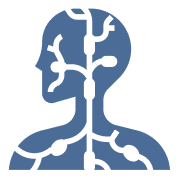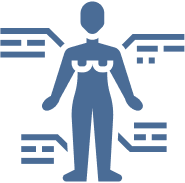Physiology Homework Help - Best Online Help For Students
Physiology, the study of how living organisms function, presents students with intricate challenges as they delve into the mechanisms that govern life processes. At TutorBin, we offer the best online support for students grappling with physiology core concepts. Our expert physiology tutors understand the complexities students face while navigating topics such as the nervous system, cardiovascular functions, and respiratory mechanisms.
Our experienced physiology tutors are committed to providing comprehensive assistance tailored to your learning needs. Whether you're deciphering the intricacies of cellular respiration or unraveling the complexities of muscle contractions, our tutors are here to guide you every step of the way.
We go beyond offering mere solutions. Our emphasis is on deepening your understanding of physiological concepts. Our tutors take the time to break down complex ideas, explain underlying principles, and guide you through the processes that drive bodily functions. We believe that grasping these fundamentals not only aids in completing assignments but also lays the foundation for a solid grasp of physiology for your academic journey and beyond. With TutorBin, conquering physiology challenges becomes attainable, helping you excel in your studies.
Physiology Homework Help - Who can seek Help Online?
Are you a student grappling with complex physiology assignments? Our online help with physiology is tailored for students at all levels, from high school to college, providing comprehensive support to enhance your understanding and grades.
1. High School Students: Building the Basics
For high school students stepping into the world of biology, physiology can be fascinating and overwhelming. Transitioning from a general understanding of life to grasping the inner workings of cells, tissues, and organs can be quite a leap. Our physiology homework helpers cater to these budding scholars, offering explanations and clarifications that bridge the gap between simple biology concepts and the more intricate world of physiology.
2. Undergraduates: Navigating the Complexity
As students delve deeper into their undergraduate studies, the complexity of physiology becomes more apparent. The breadth of topics can be overwhelming, from muscular and nervous systems to endocrine and cardiovascular systems. Our assistance is tailored to aid undergraduates in comprehending advanced concepts, deciphering intricate diagrams, and unraveling the interconnectedness of physiological processes.
3. Pre-Med and Medical Students
Beyond the Textbooks: For aspiring doctors and medical professionals, physiology is not just a subject but a cornerstone of their education. Pre-med and medical students must often grasp physiology intricately, connecting it to clinical applications and patient care. Our expert physiology assignment help offers detailed insights, clinical correlations, and case-based scenarios that bridge the gap between textbook knowledge and real-world medical practice.
4. Biomedical Researchers
Expanding Horizons: In the realm of research, physiology plays a pivotal role in understanding disease mechanisms, drug interactions, and innovative medical interventions. Biomedical researchers seeking to explore new frontiers benefit from our assistance in dissecting complex physiological pathways, analyzing experimental data, and gaining a holistic perspective on their research projects.
5. Online Learners: Overcoming Virtual Challenges
Online learning has become a norm in an increasingly digital world. However, virtual education presents its own set of challenges, including limited interaction with instructors and peers. Our physiology help online is precious for online learners, offering personalized explanations, clarifications, and support that might be lacking in a remote learning environment.
Physiology Homework Helpers Online - Is It Worth To Hire Them?
When considering hiring a physiology tutor, selecting the right expert from a reliable homework assistance platform is crucial. The process of seeking expert guidance might seem complex, with potential unforeseen challenges. This brings us to the question: Is it truly beneficial to hire online Physiology homework helpers? Our answer is a definite yes, but it's essential to weigh certain factors before deciding.
Our platform hosts a dedicated team of physiology tutors, all subject matter experts and industry professionals. They're committed to simplifying intricate concepts, ensuring an effective and engaging learning journey. At TutorBin, we ensure the smooth integration of our subject matter specialists into a well-structured academic support system. We aim to connect students with experts with extensive teaching experience, high competence levels, and a deep understanding of learning hurdles. Alongside their profound domain knowledge, our professionals are well-versed in university standards, allowing them to offer tailored assistance. Collectively, these aspects make opting for TutorBin online physiology help a precious choice.
Do My Physiology Homework Help
Challenges For Which Students Need Physiology Assignment Help
Physiology homework can challenge students due to the complex nature of biological functions and processes. Here are key challenges in the subject that necessitate do my physiology homework help to score better grades and enhance conceptual clarity:
1. Complex Terminology: Physiology involves a plethora of specialized terms and jargon that students need to learn and understand to communicate accurately. Mastering these terms can be demanding, and students may need assistance to use them correctly in their homework.
2. Integration of Multidisciplinary Concepts: Physiology is at the intersection of various scientific fields such as biology, chemistry, physics, and anatomy. Students always struggle with integrating these different concepts to form a comprehensive understanding of physiological processes.
3. Interconnected Systems: The human body comprises numerous interlinked systems with unique functions. Understanding how these systems work together to maintain homeostasis can be challenging and may require additional guidance.
4. In-depth Understanding of Processes: Physiology delves into the minute details of biological processes at the cellular and molecular levels. Students will struggle to grasp these intricacies without proper explanations and examples.
5. Visualization of Concepts: Some physiological processes involve intricate molecular interactions and pathways that can be difficult to visualize. Students will benefit from visual aids, diagrams, and interactive resources to better comprehend these processes.
6. Application of Knowledge: Applying theoretical knowledge to real-life scenarios and case studies can be complex. Students might need assistance in applying their understanding of physiology to practical situations.
7. Critical Thinking: Physiology often requires students to think critically and analyze complex situations. They will need help developing their analytical skills to approach different physiological problems effectively.
Physiology Topics & Concepts Covered
| Topics |
Concepts |
| Cellular Physiology |
Cell structure and organelles & Cellular metabolism |
| Muscular System |
Muscle contraction mechanisms & Muscle disorders |
| Nervous System |
Central and peripheral nervous systems & Neural disorders |
| Cardiovascular System |
Heart anatomy and function & Blood pressure regulation |
| Respiratory System |
Lung structure and ventilation & Respiratory control |
| Digestive System |
Enzymatic digestion & Nutrient metabolism |
Physiology Assignment Help
What Do You Get When You Pay Someone to Do My Physiology Homework?
Feeling overwhelmed with your physiology assignment? No worries! Our expert tutors are ready to take on your homework challenges, ensuring you submit accurate and well-crafted assignments on time. By availing of our services, you can expect the following:
1. Comprehensive Solutions: Our experts provide in-depth solutions to your physiology homework, ensuring all aspects are covered accurately.
2. Timely Submission: We help you meet your deadlines by delivering well-crafted assignments promptly.
3. Concept Clarity: Our physiology homework helpers clarify complex concepts, ensuring you understand the subject thoroughly.
4. Error-Free Work: You'll receive homework that's free from errors, enhancing the quality of your submissions.
5. Personalized Assistance: Our approach is tailored to your needs, addressing your specific challenges and concerns.
6. Learning Opportunity: Through our assistance, you'll get your homework done and gain insights that can help you excel in your studies.
7. Reduced Stress: Let us handle the workload, allowing you to focus on other essential tasks without feeling overwhelmed.
TutorBin Physiology Homework Help
Navigating the intricate realm of physiology can be a challenging journey for students at all levels of education. With concepts ranging from cellular processes to complex systems, seeking reliable assistance is crucial. This is where TutorBin physiology help online comes into play. Let's explore why TutorBin is the preferred destination for students seeking guidance and support in their physiology studies.
1. Expert Tutors with In-depth Knowledge: TutorBin boasts a team of expert tutors who are well-versed in physiology. These tutors have a comprehensive understanding of the subject's nuances and complexities. Their expertise ensures that students receive accurate explanations and guidance tailored to their needs.
2. Customized Learning Experience: No two students are alike, and TutorBin recognizes this. Our help with physiology homework is designed to provide a personalized learning experience. Tutors adapt their teaching methods to cater to each student's learning style, pace, and proficiency level, ensuring optimal comprehension and retention.
3. Comprehensive Topic Coverage: Physiology encompasses many topics, from cellular processes to organ systems. TutorBin covers a broad spectrum of subjects within physiology, offering assistance across various issues and concepts. Whether you're grappling with muscular systems or nervous system functions, our tutors have you covered.
4. Clarification of Complex Concepts: Physiology often involves intricate concepts that perplex students. TutorBin tutors excel at breaking down complex ideas into digestible explanations. Moreover they provide step-by-step guidance, making seemingly daunting concepts more approachable and understandable.
5. Practical Application Emphasis: TutorBin approach doesn't stop at theory. Our tutors emphasize the practical application of physiological concepts. This approach helps students connect classroom knowledge to real-world scenarios, fostering a deeper understanding of how physiology impacts everyday life and medical practice.
6. Prompt and Flexible Assistance: Homework deadlines can be demanding, leaving little room for delays. TutorBin understands the importance of timely assistance. Our platform provides quick responses, ensuring students receive the help they need to complete their assignments accurately and on time.
7. Interactive Learning Environment: Learning is most effective when engaging and interactive. TutorBin offers an interactive platform that enables students to communicate with tutors in real-time. Students can actively participate in learning through live chats, video calls, and collaborative tools.
8. Original work Solutions: Our commitment to originality ensures that the solutions provided are free from copied content, guaranteeing your work's authenticity.
9. Confidential and Secure: Privacy is a top priority at TutorBin. All interactions and information shared between students and tutors are confidential and secure. Students can seek help with physiology without concerns about their personal information being compromised.
10. Affordable and Accessible 24/7: Quality education shouldn't come with a hefty price tag. TutorBin physiology assignment help is designed to be reasonable and accessible 24/7. Every student should be able to excel in their studies without financial constraints.
11. Multiple Guarantees: When you choose our "do my physiology homework" service, we promise on-time delivery, make sure you're happy with the assignment, and provide revisions to meet all your needs.
Physiology Assignment Help - Immediate Support From Expert Tutors
Our expert physiology assignment helpers are designed to provide immediate and budget-friendly student support. We strongly believe in aiding students in their academic journey, ensuring quick responses regardless of your time zone. Connecting with our dedicated team takes just minutes; from there, our TutorBin experts take full responsibility for providing the help you need in the shortest possible time. Recognizing the importance of expert guidance during challenging periods in your studies, TutorBin has created this platform to ensure the availability of experienced professionals 24/7.
Physiology Homework Help Online Worldwide
TutorBin is your 24/7 global partner for physiology homework help, transcending geographical boundaries to assist students worldwide. Our proficient experts, well-versed in various educational systems, are ready to guide you through assignments aligning with your college's standards. Whether you're studying in the USA, Europe, Asia, or elsewhere, our tailored support ensures physiology success, regardless of your educational level or location. We're committed to making physiology accessible to all students, whether enrolled locally or remotely. With TutorBin, you're never alone on your academic journey.
Physiology Help FAQs Searched By Students
Can I pay someone to do my physiology homework help?
Yes, at TutorBin, you can pay for our qualified tutors to handle your physiology homework, leading to a better understanding and improved knowledge of the subject.
Where can I get physiology assignment help?
You can search the Internet for homework help sites like TutorBin to get expert physiology help. You just need to visit the site and drop your requirements to get professional homework help round-the-clock.
Are there online physiology homework helpers available?
Yes, at TutorBin, you'll find online physiology homework helpers who can assist you with your assignments.
What kind of physiology help can I find online?
You can find comprehensive online physiology help at TutorBin, covering topics such as anatomy, cellular functions, organ systems, and more.
How much should physiology homework cost?
There is no fixed cost for physiology homework assistance. The cost depends on the complexity of your problem areas, deadline proximity, and availability of tutors.










